Related Research Articles
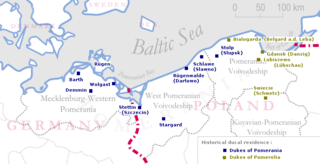
Pomerania is a historical region on the southern shore of the Baltic Sea in Central Europe, split between Poland and Germany. The central and eastern part belongs to the West Pomeranian, Pomeranian and Kuyavian-Pomeranian voivodeships of Poland, while the western part of Pomerania belongs to the German states of Mecklenburg-Western Pomerania and Brandenburg.

Szczecin is the capital and largest city of the West Pomeranian Voivodeship in northwestern Poland. Located near the Baltic Sea and the German border, it is a major seaport and Poland's seventh-largest city. As of December 2021, the population was 395,513.

Jomsborg or Jómsborg was a semi-legendary Viking stronghold at the southern coast of the Baltic Sea, that existed between the 960s and 1043. Its inhabitants were known as Jomsvikings. Jomsborg's exact location, or its existence, has not yet been established, though it is often maintained that Jomsborg was located on the eastern outlet of the Oder river. Historian Lauritz Weibull dismissed Jomsborg as a legend.
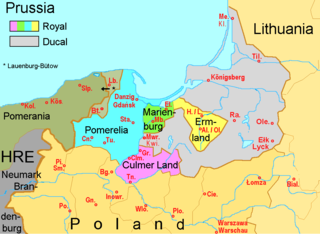
Pomerelia, also known as Eastern Pomerania, Vistula Pomerania, and also before World War II as Polish Pomerania, is a historical sub-region of Pomerania on the southern shore of the Baltic Sea.
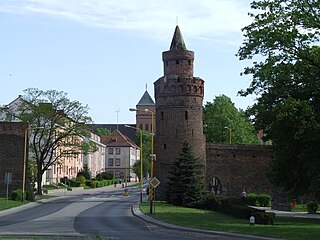
Pyrzyce is a town in Pomerania, north-western Poland. As of 2007, it had 13,331 inhabitants. It is the capital of the Pyrzyce County in West Pomeranian Voivodeship.

The history of Pomerania starts shortly before 1000 AD, with ongoing conquests by newly arrived Polan rulers. Before that, the area was recorded nearly 2000 years ago as Germania, and in modern times Pomerania has been split between Germany and Poland. Its name comes from the Slavic po more, which means "land at the sea".

Wolin is a town in northwestern Poland, situated on the southern tip of the Wolin island off the Baltic coast of the historic region of Western Pomerania. The island lies at the edge of the strait of Dziwna in Kamień County, West Pomeranian Voivodeship.
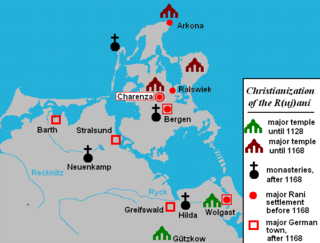
The Rani or Rujani were a West Slavic tribe based on the island of Rugia (Rügen) and the southwestern mainland across the Strelasund in what is today northeastern Germany.
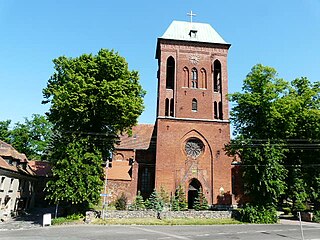
The Bishopric of Cammin was both a former Roman Catholic diocese in the Duchy of Pomerania from 1140 to 1544, and a secular territory of the Holy Roman Empire (Prince-Bishopric) in the Kołobrzeg area from 1248 to 1650.
Adalbert of Pomerania was the first bishop of the 12th century Pomeranian bishopric, with its see in Wolin. He was a monk of the Michaelsberg Abbey, Bamberg and former chaplain to Bolesław III Wrymouth of Poland, whence he knew the Pomeranian language of the temporarily Polish-subjugated West Slavic population, whereas the Joms Vikings and other Germanic inhabitants of the Pomeranian coast understood his old German language.

Pomerania during the Early Middle Ages covers the History of Pomerania from the 7th to the 11th centuries.

Pomerania during the High Middle Ages covers the history of Pomerania in the 12th and 13th centuries.

After the glaciers of the Ice Age in the Early Stone Age withdrew from the area, which since about 1000 AD is called Pomerania, in what are now northern Germany and Poland, they left a tundra. First humans appeared, hunting reindeer in the summer. A climate change in 8000 BC allowed hunters and foragers of the Ertebølle-Ellerbek culture to continuously inhabit the area. These people became influenced by farmers of the Linear Pottery culture who settled in southern Pomerania. The hunters of the Ertebølle-Ellerbek culture became farmers of the Funnelbeaker culture in 3000 BC. The Havelland culture dominated in the Uckermark from 2500 to 2000 BC. In 2400 BC, the Corded Ware culture reached Pomerania and introduced the domestic horse. Both Linear Pottery and Corded Ware culture have been associated with Indo-Europeans. Except for Western Pomerania, the Funnelbeaker culture was replaced by the Globular Amphora culture a thousand years later.

History of Pomerania (1945–present) covers the history of Pomerania during World War II aftermath, the Communist and since 1989 Democratic era.
Medieval Pomerania was converted from Slavic paganism to Christianity by Otto von Bamberg in 1124 and 1128, and in 1168 by Absalon.
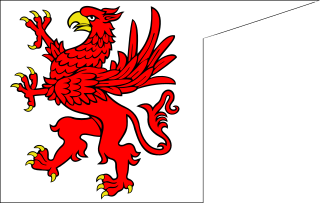
The Duchy of Pomerania-Stettin, also known as the Duchy of Stettin, and the Duchy of Szczecin, was a feudal duchy in Farther Pomerania within the Holy Roman Empire. Its capital was Szczecin. It was ruled by the Griffin dynasty. It existed in the eras of the High and Late Middle Ages, and the early modern period, between 1160 and 1264, between 1295 and 1523, and between 1532 and 1625.
The Duchy of Pomerania was partitioned several times to satisfy the claims of the male members of the ruling House of Pomerania dynasty. The partitions were named after the ducal residences: Pomerania-Barth, -Demmin, -Rügenwalde, -Stettin, -Stolp, and -Wolgast. None of the partitions had a hereditary character, the members of the House of Pomerania inherited the duchy in common. The duchy thus continued to exist as a whole despite its division. The only exception was made during a war with the Margraviate of Brandenburg, when in 1338 Barnim III of Pomerania-Stettin was granted his partition as a fief directly from the Holy Roman Emperor, while Pomerania-Wolgast remained under formal Brandenburgian overlordship. However, already in 1348, German king and later emperor Charles IV again granted the Duchy of Pomerania as a whole and the Principality of Rügen as a fief to the dukes of both Pomerania-Stettin and Pomerania-Wolgast, nullifying Brandenburg's claims by granting Imperial immediacy.
The Prissani or Pyritzans were a medieval tribe in Pomerania. They were first mentioned as "Prissani" with 70 civitas by the Bavarian Geographer, ca. 845. They are associated with the Pomeranians, and were based in the lower Oder region around the modern town of Pyrzyce (Pyritz). The mention in the Bavarian Geographer is the only written record referring to the tribe.
The Treaty of Pyzdry was signed on 2 November 1390 between Władysław II Jagiełło, king of Poland and Wartislaw VII of Pomerania-Stolp. The treaty, signed in Pyzdry, contained an oath of vassalage of Wartislaw to Jagiełło, the obligation to support the latter in the Polish-Teutonic War, and mutual trade alleviations for Pomeranian and Polish merchants. Wartislaw VII, who with his brothers was allied with the Teutonic Order before, received the Polish castellany of Nakło and probably some adjacent areas as a fief.
Beginning in the 12th century, on the initiative of monasteries, as well as the local nobility, German settlers began migrating to Pomerania in a process later termed the Ostsiedlung. The local nobles and rulers encouraged the settlement in order to strengthen and consolidate their position and to develop and intensify land use, while the settlers were attracted by the privileges that were granted to them.
References
- ↑ Johannes Hoops, Herbert Jankuhn, Heinrich Beck, Reallexikon der germanischen Altertumskunde Band 23, Walter de Gruyter, 2003, p.261, ISBN 3-11-017535-5
- 1 2 Jan M Piskorski, Pommern im Wandel der Zeiten, p.30, ISBN 83-906184-8-6 OCLC 43087092
- 1 2 3 Jan M Piskorski, Pommern im Wandel der Zeiten, p.31, ISBN 83-906184-8-6 OCLC 43087092
- 1 2 3 4 Filipowiak, Wladyslaw: Wollin - ein frühmittelalterliches Zentrum an der Ostsee, in Wieczorek, Alfried; Hinz, Hans (eds.): Europas Mitte um 1000, Stuttgart 2000, pp. 152-155; here p. 154-155.
- 1 2 Jan M Piskorski, Pommern im Wandel der Zeiten, p.36, ISBN 83-906184-8-6 OCLC 43087092
- ↑ Waldman, Carol; Mason, Catherine (2006). Encyclopedia of European peoples, Volume 1. Infobase Publishing. p. 874. ISBN 978-0-8160-4964-6.